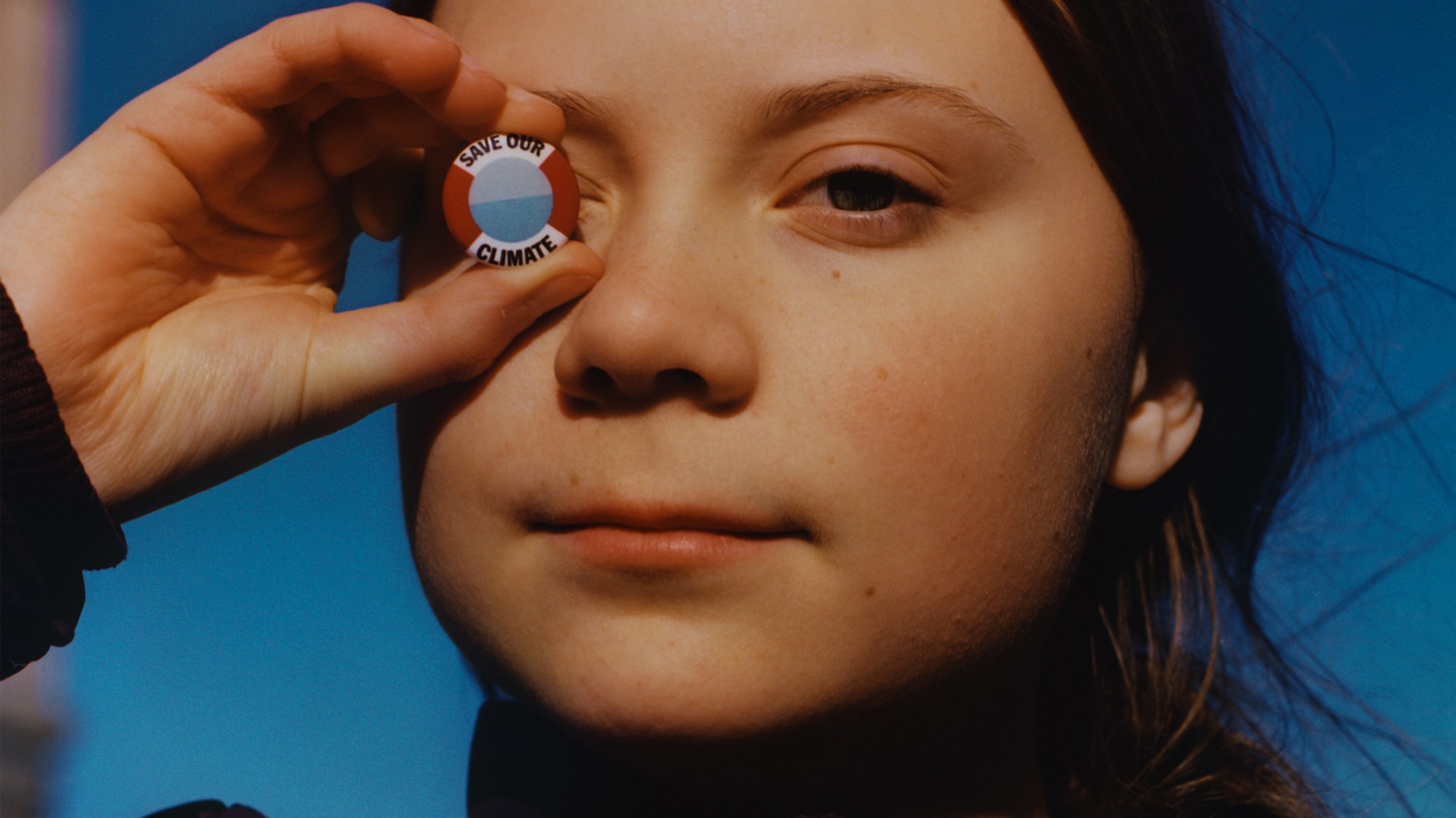This story originally appeared in i-D’s The Voice of a Generation Issue, no. 356, Summer 2019. Pre-order your copy here.
Philosopher Timothy Morton coined the term “hyperobjects” to refer to things that are a part of our lives, things that we are a part of, yet struggle to grasp. Global warming is a hyperobject — it’s a too-hot day in February in London, it’s a cyclone in Mozambique, it’s flooding in Louisiana, it’s the knowledge that half of our carbon emissions have been created in the past 25 years. Hyperobjects like climate change defy our understanding of what a ‘thing’ in the world is, they can upend our comprehension of humanity’s place on the planet. But they are not abstract, vague or distant. They are right here, and we’re living through them.
It’s early morning on Friday 22nd March in Stockholm, the week after the global youth strike, which saw over 1.4 million students from around the world ditch school for the day to demand that their future, and that of the planet, be protected. It was the biggest day of climate action ever, and it was set off by one girl.
On a cloudless day outside the Riksdagshuset, Sweden’s parliament building, a crowd of about 15 people, some adults, some kids, are milling around in small groups alongside the fast flowing Lilla Värtan waterway. Last Friday there were 15,000 kids packed into this narrow section of the city. Before reaching the small crowd, the first thing you see is Greta Thunberg’s sign leaning against a tree, instantly recognisable to anyone who’s been following the 16-year-old’s once solo strike. A piece of plywood painted white, with black lettering spelling out “Skolstrejk För Klimatet”. Greta retired the original sign a while ago; it was battered and falling apart after surviving the winter months.

Leaning against the concrete wall that lines the Lilla Värtan is Greta herself, dressed in her signature purple puffa jacket, bright pink snow trousers and rubber boots. Her wardrobe is limited, she doesn’t want new things. She’s asked her parents not to buy her Christmas or birthday presents. Greta is small for her age, her face angelic but stern. Standing nearby is Helena, who volunteers to help manage the many media requests Greta gets, and a tall guy who’d rather not be mentioned by name, who also volunteers time on Fridays to support Greta. He hovers nearby trying to keep the crowd from pressing in on the tiny climate activist. Everyone wants to talk to Greta, everyone wants a photo with her. Her tall protector got to know Greta during her first days of striking, back in August 2018, when she refused to go to school for three weeks in the lead up to the Swedish elections, instead beginning her lone strike for the planet, totally dismayed by climate change and the refusal of those in power to address it. She was inspired by the students of Marjory Stoneman Douglas High School in America, who walked out of class in protest at gun laws after 17 kids were murdered. Back then there were no crowds. “Everyone ignored me, nobody was even looking at me,” Greta says of those early weeks.
Her dad, Svante, stops by and Greta, unsmiling, asks him what he’s doing there. It’s a flash of normal teen annoyance at a parent intruding on their thing. But it might also be out of caution — those wanting to damage the movement have tried to discredit Greta, saying that she’s a puppet of her parents or some nefarious organisation trying to push its own agenda. “People always ask me who manages Greta,” Helena says. “No one manages Greta! She manages herself.”
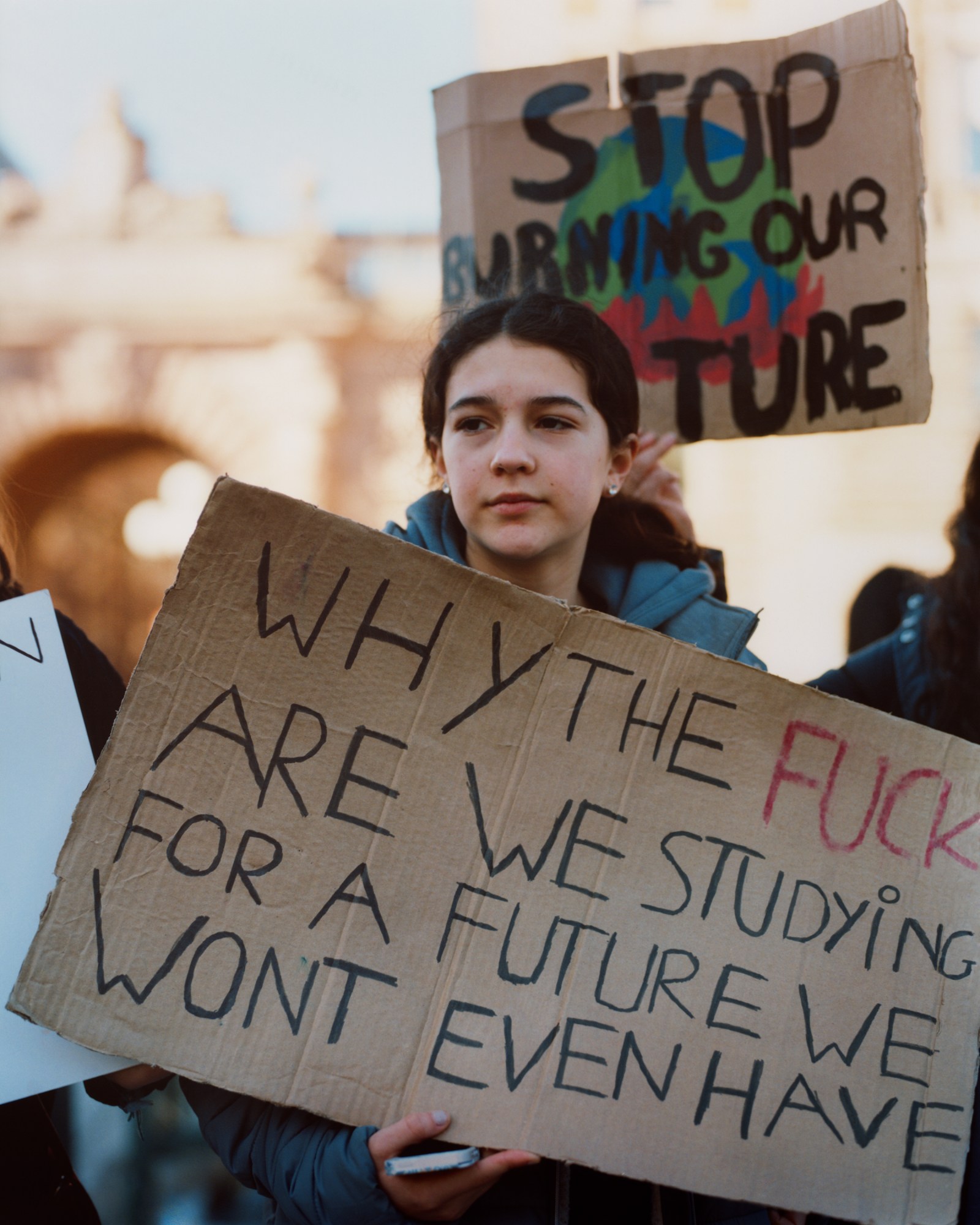
“What we desperately need is an appropriate level of shock and anxiety concerning a specific ecological trauma — indeed, the ecological trauma of our age, the very thing that defines the Anthropocene as such,” Timothy Morton writes in his book Hyperobjects: Philosophy and Ecology After the End of the World. The profound sense of shock Morton calls for is what Greta felt at a very young age, after learning about climate change in school. “When I was eight or nine years old, the teachers told us about the effects of greenhouse gases and the melting ice caps,” Greta explains. “They showed us pictures of plastic in the ocean, starving polar bears, deforestation. I just couldn’t stop thinking about them. They were stuck in my head. I thought it was very sad because no one seemed to care about what was going on. I couldn’t understand how people could, on the one hand, say that they cared about climate change and that it was very important, and then not do anything about it.”
Greta was diagnosed with Asperger syndrome when she was a child, and she credits Asperger’s as to why she felt unable to move on the way most of us can. As Greta explained in her TED talk last year, for her, as with many on the spectrum, things are black and white. This hyperobject is simple to her: it is the biggest threat humanity has ever faced, and we have to act. “If your house is on fire you don’t sit down at the table talking about how nice you’ll build it afterwards,” she says. “When your house is on fire you run outside and make sure everyone is ok and call the fire department. That is the mindset we need to have.”
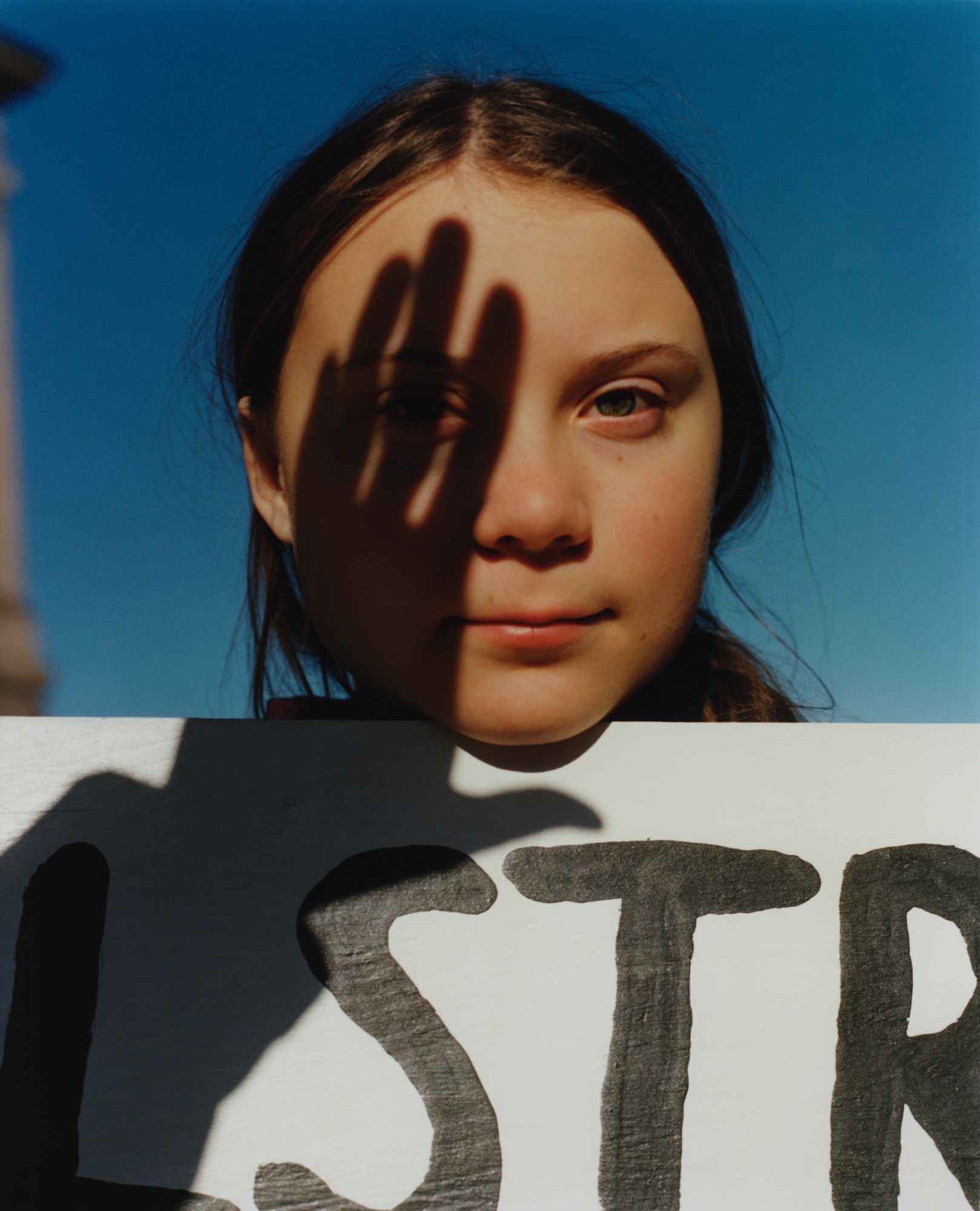
After realising the effects global warming will have on us, Greta’s life changed. “I became depressed. It was for a lot of reasons. But one of the main reasons was because of the climate crisis and the environment. So I became depressed when I was 11. I stopped talking, I stopped eating and I stopped going to school. I stopped having fun. I stopped smiling.”
Though Greta was unable to go to school at that point, something good came out of her time off — she managed to create change at home. Back then her parents had little knowledge of the crisis. “Since I was home all the time, my parents had to be home taking care of me. So then we started talking. I told them my concerns and worries about the climate and environment, and of course they were like everyone else, patting my head, saying everything will be fine. But then after a while, when I just kept on going, showing them articles, reports, graphs… they understood the emergency. They were shocked by how serious the situation was. I made them feel very guilty about their lifestyles.” Greta’s mother was a very successful opera singer who performed around the world, but following Greta’s lead she has given up flying. They take trains when they need to travel. Her parents are vegan, like Greta, and they’ve cut down as much as possible on buying new things. Though Greta is quick to point out that the difference an individual can make in terms of emissions is minuscule, and that it’s up to governments and corporations to follow IPCC guidance if we hope to avoid total catastrophe, she still wants to live in a way that minimises her impact on the planet.

Since rising to global prominence off the back of the strike movement and its growing impact, Greta has been invited to speak to politicians around the world. In the last year alone, she has made a speech at the UN’s Climate Change Conference, been nominated for the Nobel Peace Prize, and unflinchingly called the world’s richest citizens to account at the World Economic Forum. “I got a look at how things are run and I realised we don’t have things under control. You often get the picture that we do, that there are politicians who are trying, but I’ve spoken to many politicians that don’t even know what they’re doing, what’s going on… They are just very lost, it seems.”
As midday approaches the crowd around Greta grows bigger. “It used to be mostly older people,” Helena says, but recently more young people have been stopping by or spending the day. Today there is a group of 11-year-old boys from Örjanskolan School, a good two hours from Stockholm, sitting piled on top of each other, leaning against the concrete bridge. Their teacher, Anja, brought them here to support Greta as part of a project they’re doing on climate change. Anja shows off the sign the boys have made. She says she didn’t realise how serious climate change was until she became aware of Greta. A group of kids walking on the other side of the waterway yell out “Hi Greta!”
Nearby, a group of men in their sixties stand with signs around their necks that say “Old guys thinking about climate change”. They want to tell Greta that they’re sorry, they know that they’re part of the generation that really messed things up. Three tall teenage boys wait patiently for a chance to take a photo with her. She obliges and they tower over Greta, smiling at the camera. A woman walks up to her and hands her a rose, then wraps her arms around Greta. People with extremely long camera lenses jostle to get a clear shot of her, clicking endlessly. Her protector asks the crowd to back off a bit, but everyone wants a piece of her. It’s intense just to watch, let alone for a girl who’s used to fading into the background, a girl who doesn’t do small talk. Her peers, though, give her space.
A group of teenagers who’ve come to support Greta sit in a circle nearby eating packed lunches. They didn’t know each other before today, but they’ve made a connection now, sitting and chatting. Among them is 16-year-old Esther, here today by herself for her first strike. Her friends wouldn’t join her — they don’t agree that global warming is a big issue — but she’s passionate about it.
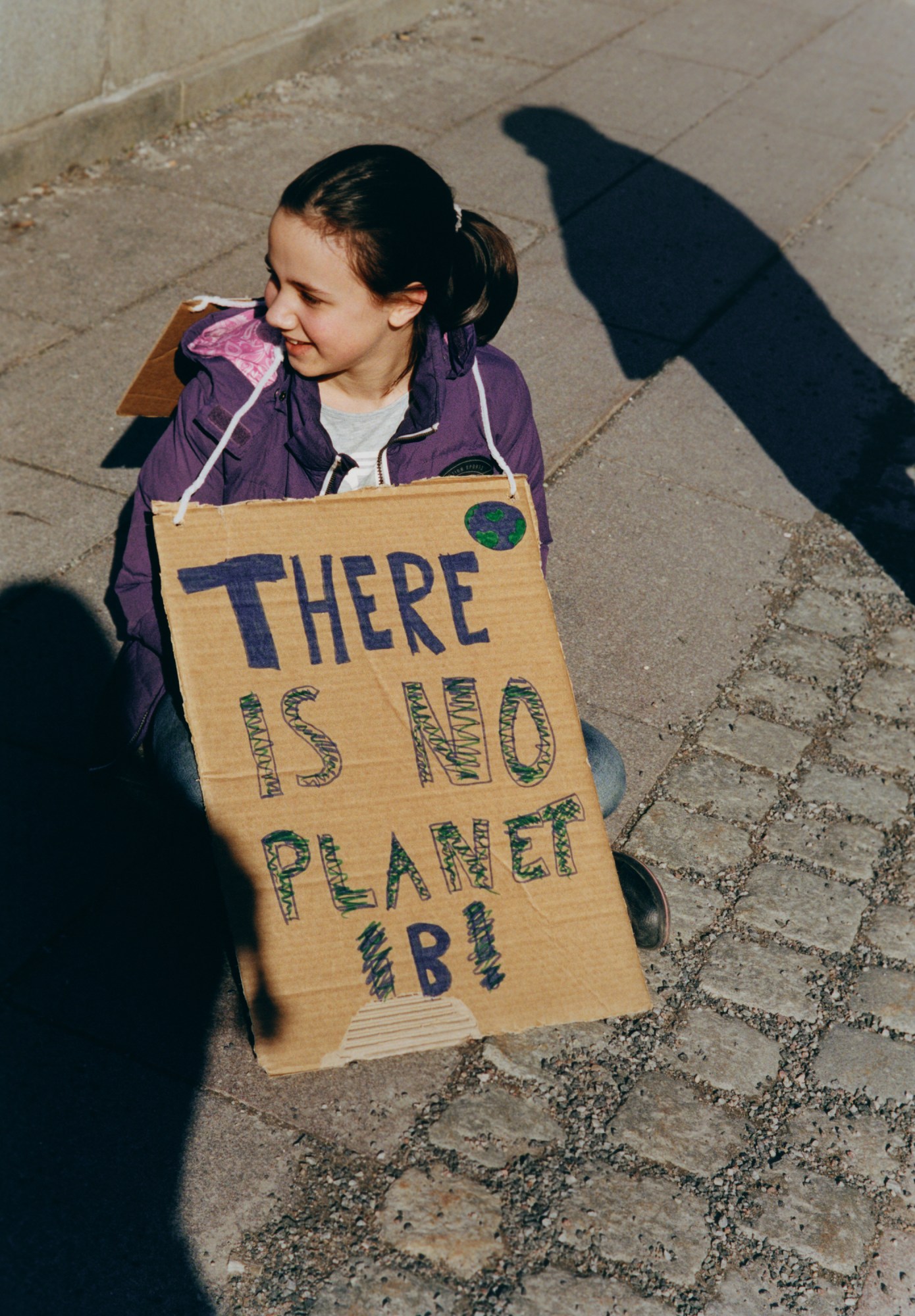
It was three weeks into her school strike when Greta realised she needed to keep building momentum. “I thought, why should I stop now when people are listening? If I stopped then it would look like it was over and it was just a one-time thing. So I decided to continue to strike every Friday. I never imagined that it was going to be this big. I didn’t think people really cared about it. But I think more people care than you can see. It was like a movement waiting to happen.”
While detractors say that students just like an excuse to skip school, if you talk to the kids who’ve joined the strike it’s clear that they are deeply concerned about their future, and frustrated by their lack of power and inability to vote. This is the generation that is starting to really feel the ecological trauma, who will live through it. They’ve been born into an era of profound eco-anxiety, and they’re not able to push it to the back of their minds as generations before them have. They see it here and now, not as some separate entity ‘out there’, but as part of them, part of the fabric of their lives.
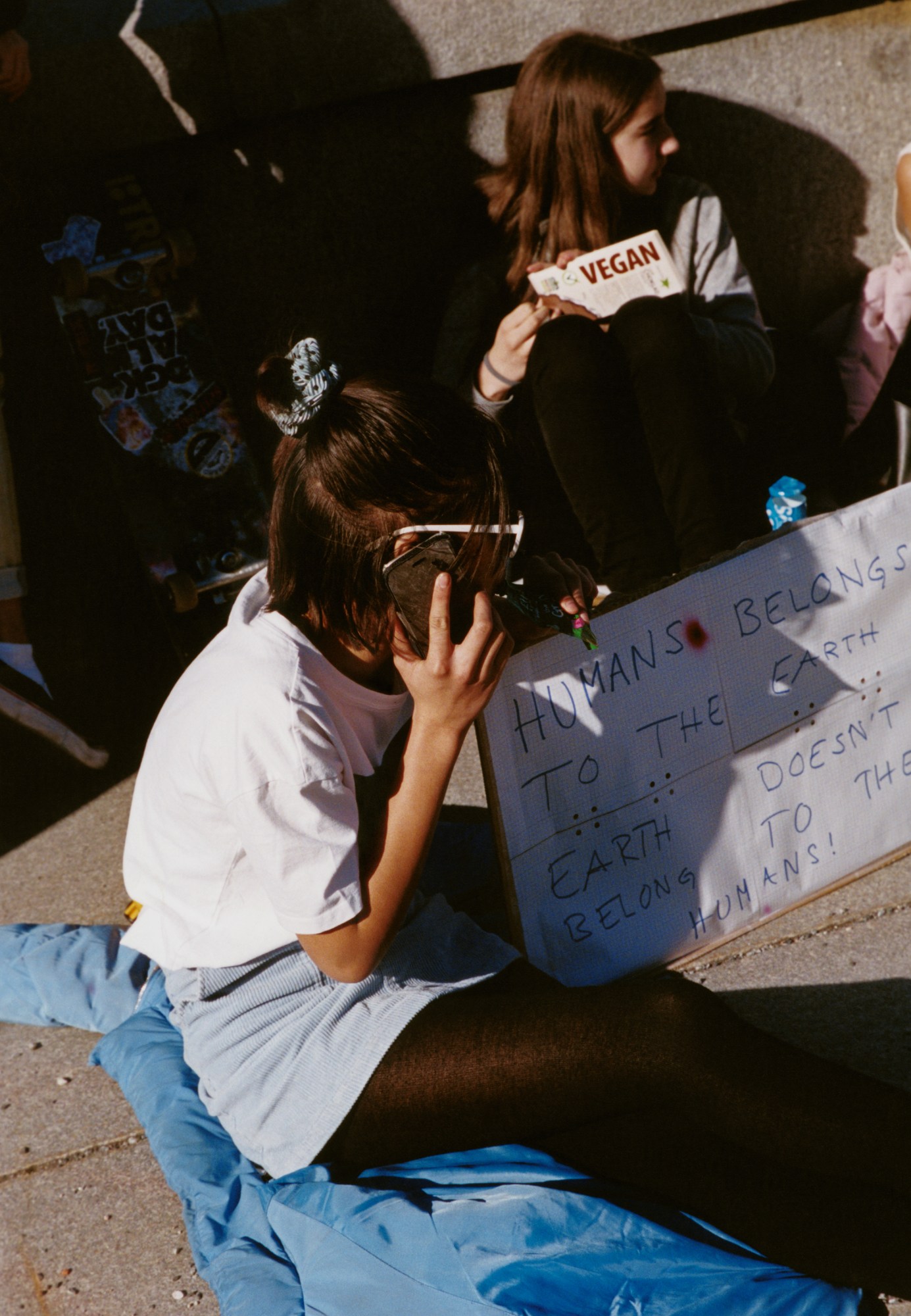
Greta is still trying to get her head around what her lone strike has become. “I can’t really understand it. After the strike I was so tired I couldn’t think straight — so the day afterwards I sat looking through maps of strike events and pictures from all around the world, and it’s like… it’s hard to realise… hundreds of thousands of children striking in just one city.”
Greta has a message for her fellow strikers. “We need to continue to put pressure on people in power and say that we will not stop until they do something. Because, yes, we have accomplished a lot. We have gathered many people. But emissions are still increasing so we have not succeeded. We need to continue until we do.”
“Many people say that this movement has become so big and ask me if I’m proud, but we haven’t seen anything yet. The climate crisis is only going to become worse, to become bigger and bigger and more urgent with time. This is not a one-time thing, this is our entire future.” So what’s next? The answer is black and white.




It’s time that we put the climate crisis into the spotlight. We’re petitioning the UK government to commit to a yearly National Climate Day, and with your help it can become a reality.
Credits
Photography Harley Weir
